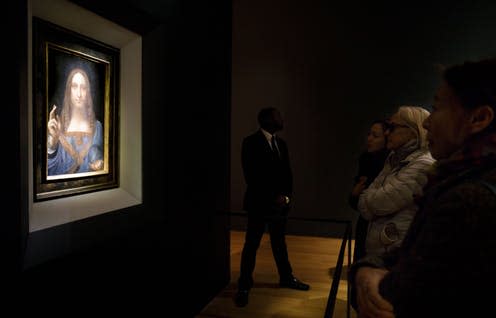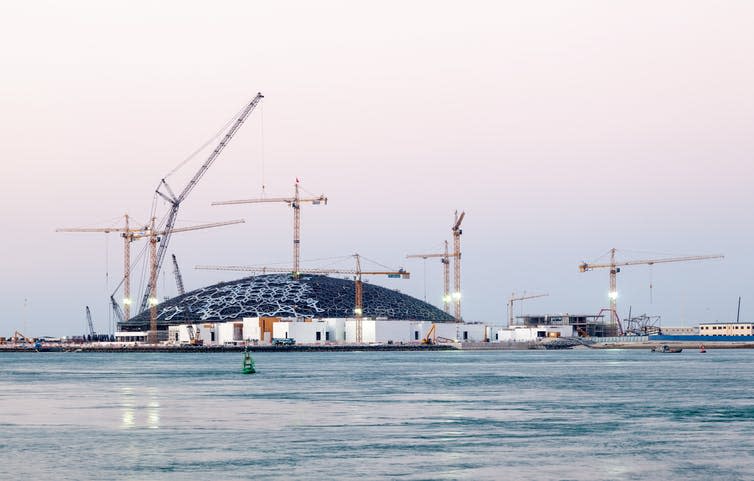No matter who bought it, we hope Leonardo's $450m masterpiece won't disappear from the public view

The sale of Leonardo da Vinci’s Salvator Mundi for US$450m (£342m) raised many of the familiar questions about the authenticity of the painting, the astronomical sums of money paid for single works of art that bear no relation to anything else openly sold – and the audience for this image in the future.
Is this painting by Leonardo? For many years the painting was thought to be the work of an artist (some people believed Giovanni Boltraffio) in da Vinci’s circle. But after careful cleaning and analysis by scholars, before and since it appeared in the National Gallery’s exhibition of 2011-12, there is now a fairly general consensus that the work is authentic. The auction house which sold the painting, Christie’s, has also conducted a clever publicity campaign to promote its authenticity.
So far, television pundits have been more prominent in talking about the sale than established Leonardo scholars – but many factors add up to a likelihood that what we are seeing here is a Leonardo original of around 1500, towards the end of his time in Milan.
The painting is thought to have been commissioned by Louis XII of France and Anne of Brittany, shortly after the conquests of Milan and Genoa. From there it accompanied Louis’ descendant, Queen Henrietta Maria, to England when she married Charles I. After his execution it was sold into the Royal Collection in part payment of the late king’s debts. From there it disappeared in the 18th century.

The chain of evidence is not ideal, but many details of the painting share a handling of paint with other long-attested Leonardo pictures. But it has a very different “presence” to his portraits, which betray Leonardo’s fascination with subtle shifts of thought and movement by their sitters. By contrast, this is a miraculous image of the Saviour of the World – his features based on long-venerated images of Christ that were superstitiously believed not to have been created by human hands, but by some divine force, a little like the image of Christ on the Turin Shroud was believed to be supernaturally created. The perfection of the rock crystal of the orb, delicately conveyed in its highlights, echoes this sense of the divine.
Record-breaking price
How does a painting like this command such as high sum in the auction room? No painting by Leonardo has ever come up for auction – and the last sale was the Ginevra de’ Benci from the Leichtenstein collection to Washington’s National Gallery 50 years ago. The gallery paid US$5m – at that time for highest price ever achieved for a work of art.
Add to this the reported sale of Salvator Mundi for £45 at Sotheby’s in 1958 – when it was still thought to have been painted by Boltraffio – and you have a first-rate art history romance.
The likely competitors at auction for Salvator Mundi (we do not know at present who they were) deal in billions, so a contest between them drove up the price. One conclusion of course is that such a work is “worth” that sum only to the person who has paid for it. Interestingly, all other paintings that have commanded prices in excess of US$100m are works by great 20th-century masters, Picasso, Bacon, de Kooning.
The glamour of 20th-century modernism has proved the most attractive to buyers who want large-scale works for company offices or to stamp their name as benefactors in the creation of new museums in the Middle East or East Asia.
Will Salvator Mundi disappear?
This makes us wonder who will now see Leonardo’s painting? It will certainly not prove to have been one of the established museums of Europe or the United States as the buyer, the price is way beyond their reach even with the most generous of donors behind them.

It may well have been purchased for one of the several new “floating island” museums of the Middle East, such as the new Louvre in Abu Dhabi.
We have entered a time when those with such sums to spare often see it as self-serving to place their purchases into the public realm – and we hopefully are now adult and generous enough not to think such things necessarily have to stay close to their place of origin. The main thing is that they are accessible to a wide public.
Thanks to the increasingly regular loans between museums and the enthusiasm of private collectors to lend art for exhibitions, the doing of deals for temporary exchanges of works of art are now commonplace. I suspect many across the world will see the Leonardo again.
This article was originally published on The Conversation. Read the original article.

Maurice Howard receives funding from Arts and Humanities Research Council, The Leverhulme Trust and the Paul Mellon Centre for Studies in British Art.

 Yahoo News
Yahoo News 